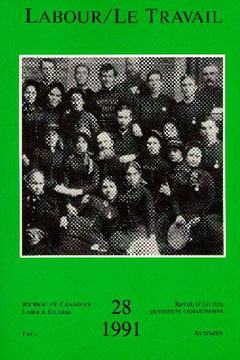Abstract
In the 1880S both the Knights of Labor, and the Salvation Army, which in this period was an exclusively revivalistic movement, drew mass support from Ontario's working class. This paper looks at the nature of working class support for the two movements, noting that the Salvation Army was more likely to attract working class women and unskilled men, while the Knights were most popular among skilled men. The possibility of overlap in membership is also addressed.
In assessing the appeal of the two movements to working class Ontarians the relationship between working class religion and class consciousness is explored. Christianity was clearly important to many individual Knights, and fueled the Order's class conscious critique of nineteenth century society. The Salvation Army's otherworldly emphasis meant that it ignored contemporary social and economic issues; nonetheless the Army provided a distinctly working class religious alternative which was actively critical of the respectable mainstream churches. The popularity of both the Knights and the Army demonstrate the importance of class identity and religious belief within the late nineteenth century Ontario working class.
Résumé
Au cours des années 1880, l'Ordre des Chevaliers du Travail et l' Armée du Salut rallièrent un grand nombre d'adhérents parmi les travailleurs en Ontario. Cette étude examine la nature d'un tel appui ouvrier au sein des deux mouvements. Tandis que les Chevaliers formaient une association surtout populaire auprès des ouvriers spécialisés, le mouvement de l'Armée du Salut, alors destiné exclusive ment au renouveau de la foi, était plus susceptible d'attirer les femmes ouvrières et les travailleurs non-qualifiés. Mais il faut également tenir compte de la possibilité d'un chevauchement entre ces deux groupes d'adhérents.
L'attrait de ces deux mouvements chez les travailleurs ontariens soulève la question du rapport existant entre la religion ouvrière et la conscience de classe. Manifestement important pour plusieurs Chevaliers individuels, le christianisme alimenta leur critique prolétarienne de la société du dix-neuvième siècle. En mettant l'accent sur le détachement temporel, l'Armée du Salut ignorait les questions sociales et économiques contemporaines; elle offrait cependant à la classe ouvrière une alternative religieuse fort critique des conventions et institutions religieuses traditionnelles. La popularité de ces deux mouvements illustre toute l'importance de l'identité de classe et de la foi religieuse parmi les ouvriers et les ouvrières ontariens de la fin du dix-neuvième siècle.
